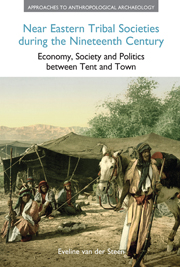 Near Eastern Tribal Societies during the Nineteenth Century
Near Eastern Tribal Societies during the Nineteenth Century Book contents
- Frontmatter
- Dedication
- Contents
- Acknowledgements
- Introduction
- 1 What is a tribe?
- 2 Travellers in the Levant during the nineteenth century
- 3 The dynamics of territorial and power structures
- 4 Oral traditions
- 5 Tribal society and its relation to the landscape
- 6 Tribal institutions
- 7 Relations between the tribes and the state
- 8 From tribe to tribal state: three case studies
- 9 The economy of tribal societies
- 10 Ethnicity and the sense of belonging
- 11 Women in tribal societies
- 12 Religion and folklore
- 13 Back in time: historical parallels
- Notes
- References
- Index
1 - What is a tribe?
- Frontmatter
- Dedication
- Contents
- Acknowledgements
- Introduction
- 1 What is a tribe?
- 2 Travellers in the Levant during the nineteenth century
- 3 The dynamics of territorial and power structures
- 4 Oral traditions
- 5 Tribal society and its relation to the landscape
- 6 Tribal institutions
- 7 Relations between the tribes and the state
- 8 From tribe to tribal state: three case studies
- 9 The economy of tribal societies
- 10 Ethnicity and the sense of belonging
- 11 Women in tribal societies
- 12 Religion and folklore
- 13 Back in time: historical parallels
- Notes
- References
- Index
Summary
“I gave you food,” said Jack, “and my hunters will protect you from the beast. Who will join my tribe?”
(William Golding, Lord of the Flies)Introduction: what is a tribe?
One thing that is clear in the discourse about “tribes”, “tribalism” and “tribal societies” is that the word “tribe” has different meanings for different people. For some it has connotations with Karl May and his romantic heroes, Winnetou and Kara ben Nemshi. Others think of African bush or desert tribes and bands that have been described by European and American anthropologists. Those with a classical background may associate the word with the Celtic and Germanic tribes of pre-Roman and Roman Europe. All of these groups have traits in common: they are aggressive, warlike, sometimes heroic and primitive – at least compared to the civilization to which the narrator belongs.
Jack's “tribe” in Golding's book conforms to that image: aggressive hunters, painted in war-colours, with a chief at the top who orders the fighting and killing. But he adds another element: that of group cohesion, of belonging, and belonging particularly for the purposes of finding food and protection. This second aspect is more prominent in the meaning of the word in the modern English idiom: “the rules of the tribe” refers to social class. It is about belonging, about conforming to the rules that define a group as a form of self-identification.
- Type
- Chapter
- Information
- Near Eastern Tribal Societies during the Nineteenth CenturyEconomy, Society and Politics between Tent and Town, pp. 1 - 17Publisher: Acumen PublishingPrint publication year: 2013


